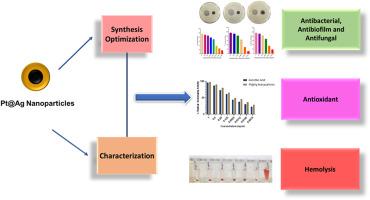An integrated paradigm to understand the antibacterial and antifungal potential of bimetallic core-shell platinum silver (Pt@Ag) nanoparticles: A one health approach
IF 3.5
3区 医学
Q3 IMMUNOLOGY
引用次数: 0
Abstract
The concurrent occurrence of various microbial infections escalates the need to develop new treatments that can tackle multiple microbes and improve clinical outcomes. This study reports the synthesis and comprehensive evaluation of core-shell platinum-silver nanoparticles (Pt@AgNPs) designed to elucidate the antimicrobial effects while ensuring biocompatibility. The synthesis protocol was meticulously optimized to investigate the impact of precursor concentrations and reagent conditions. High-end characterization confirmed the formation of a well-defined core-shell structure with spherical morphology, crystalline nature, a face-centred cubic (FCC) lattice, high monodispersity, and stability, with a mean size of 20.344 ± 4.492 nm. The antimicrobial potential of Pt@AgNPs was validated through a minimum inhibitory concentration (MIC) assay, revealing potent activity with MIC values of 15.6 μg/mL for Pseudomonas aeruginosa and Staphylococcus aureus and 3.9 μg/mL for Escherichia coli. Antibiofilm assay demonstrated significant inhibition of biofilm formation by P. aeruginosa at concentrations as low as 3.9 μg/ml. The nanoparticles also exhibited notable antifungal activity, as indicated by an inhibition of 65.19 % for Aspergillus niger and 61.82 % for Fusarium verticillioides. Furthermore, hemocompatibility was noticed with the hemolysis assay, and the antioxidant properties of nanoparticles, assessed through the 2,2-diphenyl-1-picrylhydrazyl (DPPH) assay, underscored their potential to mitigate oxidative stress. This integrative study positions Pt@AgNPs as a promising platform for combating the occurrence of co-infections. The core-shell nanoparticle serves as a versatile tool in antimicrobial defence, exhibiting antibacterial, antifungal, antibiofilm, and antioxidant activity. Thus, it highlights their commercial translational potential as a next-generation antimicrobial intervention.

了解双金属核壳铂银纳米粒子(Pt@Ag)抗菌和抗真菌潜力的综合范例:一种健康方法。
同时发生的各种微生物感染升级需要开发新的治疗方法,可以解决多种微生物和改善临床结果。本研究报道了核壳铂银纳米颗粒(Pt@AgNPs)的合成和综合评价,旨在阐明抗菌作用的同时保证生物相容性。精心优化了合成方案,以考察前体浓度和试剂条件的影响。高端表征证实形成了一个明确的核壳结构,具有球形形态,结晶性质,面心立方(FCC)晶格,高单分散性和稳定性,平均尺寸为20.344±4.492 nm。Pt@AgNPs对铜绿假单胞菌和金黄色葡萄球菌的最低抑菌浓度(MIC)为15.6 μg/mL,对大肠杆菌的最低抑菌浓度为3.9 μg/mL。抗生物膜实验表明,在低至3.9 μg/ml的浓度下,铜绿假单胞菌对生物膜的形成有明显的抑制作用。纳米颗粒对黑曲霉的抑制率为65.19%,对黄萎病镰刀菌的抑制率为61.82%。此外,通过溶血实验发现了血液相容性,通过2,2-二苯基-1-苦味酰肼(DPPH)实验评估了纳米颗粒的抗氧化性能,强调了它们减轻氧化应激的潜力。这项综合研究将Pt@AgNPs定位为打击合并感染发生的有希望的平台。核壳纳米颗粒作为抗菌防御的多功能工具,具有抗菌、抗真菌、抗生物膜和抗氧化活性。因此,它强调了它们作为下一代抗菌干预药物的商业转化潜力。
本文章由计算机程序翻译,如有差异,请以英文原文为准。
求助全文
约1分钟内获得全文
求助全文
来源期刊

Microbial pathogenesis
医学-免疫学
CiteScore
7.40
自引率
2.60%
发文量
472
审稿时长
56 days
期刊介绍:
Microbial Pathogenesis publishes original contributions and reviews about the molecular and cellular mechanisms of infectious diseases. It covers microbiology, host-pathogen interaction and immunology related to infectious agents, including bacteria, fungi, viruses and protozoa. It also accepts papers in the field of clinical microbiology, with the exception of case reports.
Research Areas Include:
-Pathogenesis
-Virulence factors
-Host susceptibility or resistance
-Immune mechanisms
-Identification, cloning and sequencing of relevant genes
-Genetic studies
-Viruses, prokaryotic organisms and protozoa
-Microbiota
-Systems biology related to infectious diseases
-Targets for vaccine design (pre-clinical studies)
 求助内容:
求助内容: 应助结果提醒方式:
应助结果提醒方式:


